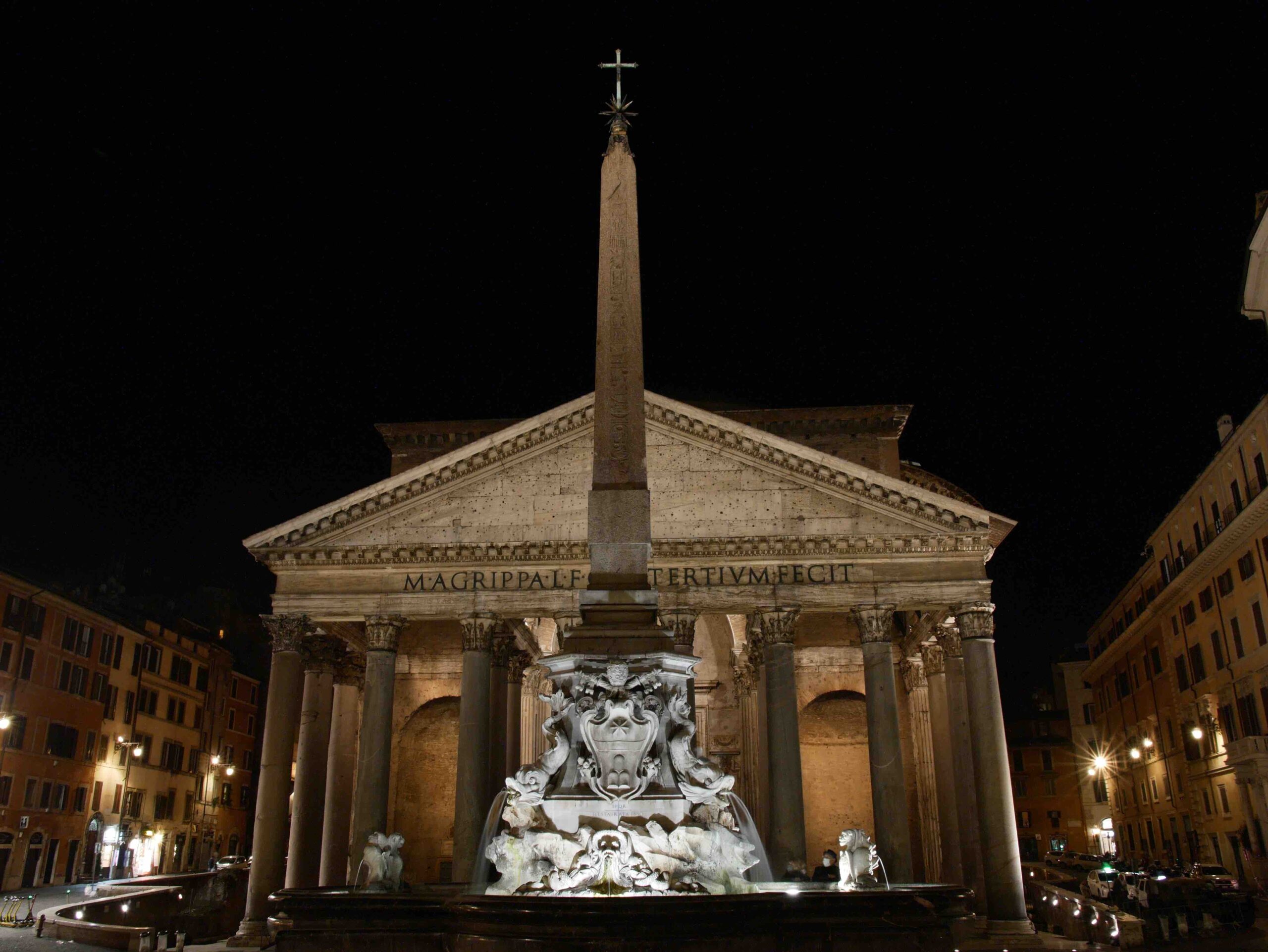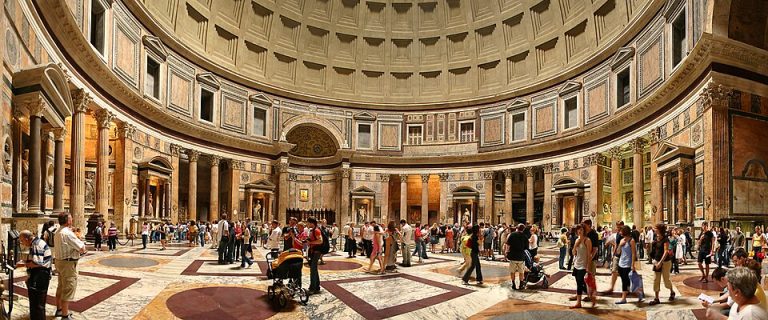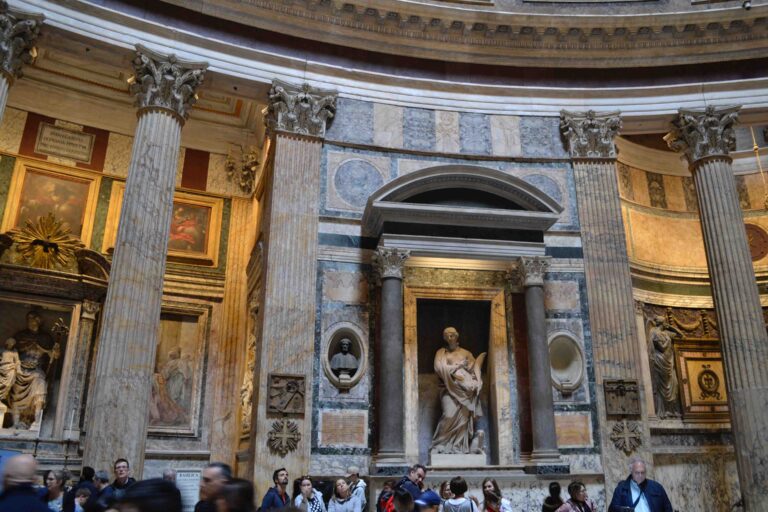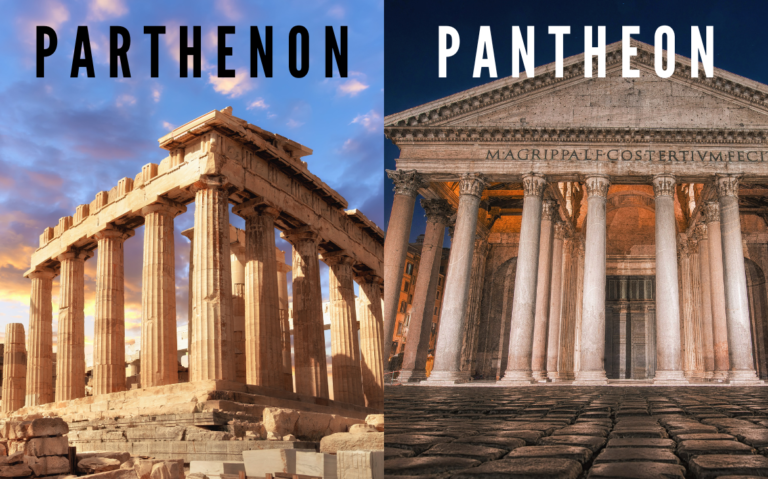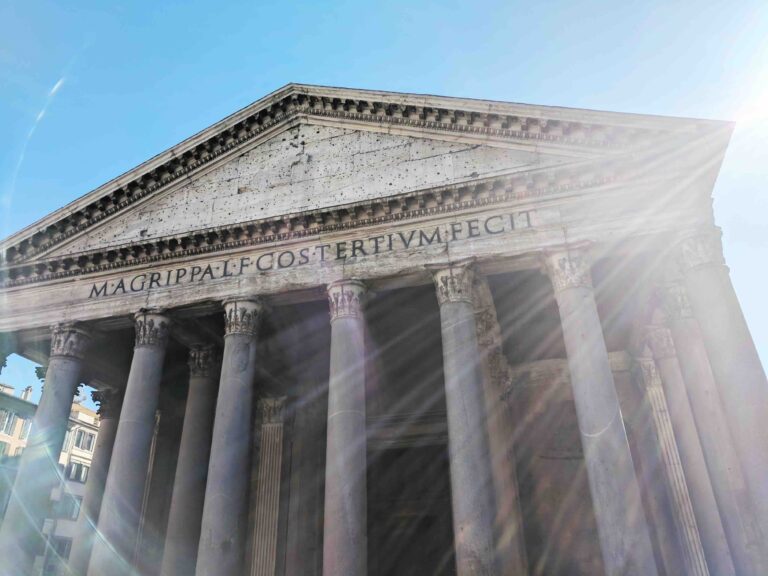Have you ever stood beneath something so magnificent that it actually makes you laugh? Not a funny laugh, but that quiet, breathy chuckle of pure disbelief. I’ve been guiding tours through Rome for over fifteen years, and I still get that feeling every single time I walk into the Pantheon. I watch our visitors, their heads tilt back, their jaws go slack, and that same sound of wonder escapes them.
Most people arrive with a checklist. They know it’s old, they know it has a hole in the roof. But what they leave with are stories. The kind of Pantheon fun facts that stick with you long after you’ve flown home. That’s the magic of this place. It isn’t a static monument; it’s a living, breathing puzzle box of engineering genius and historical twists. So, let’s move beyond the textbooks. I want to share with you the secrets and stories we tell on our Pantheon Rome tours, the ones that truly bring these ancient stones to life.
1. The Heavenly Skylight: The Oculus That Connects Earth and Sky
Let’s start with the most obvious head-scratcher: the giant, gaping hole in the center of the dome. We call it the oculus, which is just a fancy word for “eye.” And what an eye it is! This 27-foot-wide opening is the building’s only source of natural light. No windows, no side doors with light streams, just this one, perfect circle open to the heavens.
Now, the first question everyone asks is, “What happens when it rains?” It’s a great question! The answer is simple: it rains inside. But the Romans were masters of practical magic. If you look closely at the magnificent marble floor, you’ll see it’s ever-so-slightly curved, with 22 almost invisible little drainage holes. The water slips away efficiently, and honestly, watching the rain fall through that beam of light is one of the most magical experiences you can have in Rome. It reminds you that this isn’t a museum exhibit trapped in glass; it’s a building that lives and breathes with the world outside.
That oculus was a profound spiritual statement. It was the connection between the temple below and the gods above. The light it admits isn’t just static; it’s a slow, dramatic performer. The beam creeps across the interior, highlighting different niches and altars, turning the entire space into a colossal cosmic clock. This is one of the most fundamental Pantheon fun facts: the building itself is in a constant, silent conversation with the sun.
2. The Unbeaten World Record Holder
Here’s a fact that never fails to amaze our tour groups: the Pantheon’s dome is still the world’s largest unreinforced concrete dome. Let that sink in for a moment. It was completed around 128 AD, and nearly 2,000 years later, no one has ever built a larger one without using steel beams or rebar to hold it up.
To put its size into perspective, imagine a perfect concrete sphere. The dome is so vast and perfectly engineered that if you were to complete the sphere it represents, the bottom would just kiss the floor. It’s wider than the football field in a modern stadium, built with a technology we’ve arguably lost to history. This single fact elevates the Pantheon Rome from a beautiful ruin to a peerless engineering marvel. It’s a record that has stood for almost two millennia, and it shows no signs of being broken anytime soon.
3. The Secret Geometry: A Circle Within a Square
From the outside, the Pantheon can be a little deceiving. It presents itself with a very traditional, triangular-topped porch. But step inside, and the world transforms into a breathtaking cylinder capped by that heavenly half-sphere. The real secret, though, is in the proportions.
The architects designed the interior as a perfect sphere. The distance from the floor straight up to the very center of the oculus is exactly equal to the diameter of the circular wall. This perfect harmony is why the space feels so sublimely balanced. It doesn’t feel heavy or crushing, even though you’re standing under thousands of tons of concrete. It feels light, airy, and celestial.
This perfect geometry wasn’t an accident. It was a deliberate representation of the Roman understanding of the world, the square of the earthly realm contained the circle of the heavens. It’s a hidden code that creates an undeniable feeling of peace and order. When you visit the Pantheon, you’re not just walking into a building; you’re stepping inside a mathematical and philosophical idea made real in brick and mortar. It’s one of those facts about the Pantheon that you can’t unsee, and it forever changes how you appreciate the genius of Roman design.
4. The Humble Emperor: The Inscription That Doesn’t Tell the Whole Story
Now, if you’re looking at the massive, bold letters across the front of the Pantheon, you might think you have the whole story. It reads: “M·AGRIPPA·L·F·COS·TERTIVM·FECIT.” This translates to “Marcus Agrippa, son of Lucius, built this in his third consulship.”
And here comes one of the most delicious Pantheon fun facts: Marcus Agrippa did build a Pantheon on this exact spot… but that original temple burned down long before the one we see today was built. The current masterpiece was actually commissioned by Emperor Hadrian around 126 AD.
So why isn’t Hadrian’s name up there? In a world where emperors loved stamping their names on everything, this was a remarkable act of humility and respect. Hadrian, a huge admirer of classical Greek and Roman architecture, chose to credit the original founder instead of taking the glory for himself. It’s a rare glimpse into the character of a man who saw himself as a restorer of tradition, not just a builder of his own legacy. That simple inscription is a 2,000-year-old lesson in giving credit where credit is due.
5. The Miracle Concrete: A Recipe Lost to Time
Let’s talk about the stuff the Pantheon is actually made of: Roman concrete. If you’ve ever wondered how this building has stood for millennia while some modern structures crumble after decades, you’re asking the right question. The secret is in a recipe that we are still trying to fully understand today.
Modern concrete often uses steel bars for tension strength, but it’s vulnerable to cracking and weathering over time. Roman concrete was different. Recent studies have shown that the Romans used a mix of volcanic ash, lime, and seawater, creating a kind of chemical reaction that actually makes the concrete stronger over time. Tiny cracks in the structure can be “healed” by lime clasts in the mixture that react with rainwater.
Furthermore, they were brilliant engineers. They understood load. The base of the dome is made of heavy, dense concrete mixed with travertine. But as the dome rises, the aggregate mix changes. At the very top, surrounding the oculus, they used incredibly light, porous pumice stone. Think of it like a perfectly layered cocktail or a cappuccino, the heaviest stuff is on the bottom, the lightest, frothiest stuff is on top. This ingenious use of material is a cornerstone of Pantheon architecture and a key reason why it still proudly stands today.
6. The Ultimate Illusion: The Dome You Can’t See
Here’s a fun game to play before you enter: stand in the Piazza della Rotonda and look up at the Pantheon. What shape does the building appear to be? Most people see a fairly standard, blocky temple front with a triangular pediment. The massive, world-record-holding dome is almost completely hidden from view.
This was no accident. The architects used a clever three-tiered design to disguise the dome’s sheer scale from the outside. By building a transitional block between the porch and the rotunda, they created a visual trick that makes the exterior seem much more modest and earth-bound. Why would they do this?
The answer is all about the drama of contrast. By designing a humble exterior, they amplified the “wow” moment of stepping inside. The transition from the crowded, sunlit square into the vast, shadowy, and celestial interior is one of the most powerful experiences in architecture. It was designed to take your breath away. This deliberate shift from the human scale to the divine is one of those brilliant facts about the Pantheon that highlights the Romans’ deep understanding of spectacle and emotion.
7. The Great Escape: How Becoming a Church Saved the Pantheon
Walk through Rome, and you’ll see countless ancient ruins, skeletons of buildings stripped of their marble and finery. So why does the Pantheon stand in such breathtakingly perfect condition? The answer is one of history’s great ironies.
In the year 609 AD, the Byzantine Emperor Phocas gifted the building to Pope Boniface IV. The Pope then consecrated it as a Christian church, dedicated to St. Mary and the Martyrs. This single act of conversion is the sole reason we can still admire it today.
You see, when Rome fell, many of its magnificent ancient structures were abandoned. They became convenient quarries, their marble facades and bronze fittings stripped away to build new palaces and churches. But because the Pantheon was an active, functioning church, it was protected, maintained, and preserved through the centuries. Its spiritual purpose evolved, but its physical structure was saved. It’s a humbling thought: this temple to all the Roman gods found a second life, ensuring its survival for us to wonder at today. This is perhaps one of the most crucial Pantheon fun facts for understanding its very existence.
8. The King and the Artist: The Famous Tombs Inside
The Pantheon isn’t just an architectural marvel; it’s also a final resting place for some very famous figures, which adds a deeply human layer to its story. Inside, you’ll find the tombs of two of Italy’s first kings: Vittorio Emanuele II and Umberto I, which gives the space a continued national significance.
But for many, the most poignant tomb is that of the Renaissance artist Raphael. Dying tragically young at just 37, his funeral was a major event, and his burial here was a testament to his fame. His presence in the Pantheon creates a powerful bridge between the ancient Roman world and the height of the Renaissance, two golden ages of art and human achievement meeting under one roof.
On his tomb, you’ll find a beautiful and moving epitaph, written by the scholar Pietro Bembo. It reads: “Here lies Raphael, by whom Nature herself feared to be outdone while he lived, and when he died, feared that she would die with him.” It’s a fitting tribute to a man who captured beauty so perfectly, and standing before it is always a quiet, reflective moment on our Pantheon Rome tours.
9. The Living Sundial: A Light Show Older than Rome itself
We talked about the oculus letting in light, but it’s so much more than a skylight. It’s the heart of a dynamic, ever-changing display. That beam of sunlight isn’t random; it’s a meticulously engineered phenomenon. It sweeps across the interior like the hand of a colossal clock, illuminating different parts of the rotunda throughout the day.
At different hours, the light highlights the altar, dances across the coffered ceiling, or spotlights the center of the floor. This wasn’t just for show; it was a way to mark the hours and the seasons, tying the temple’s rituals to the cosmos itself. The most spectacular alignment happens at midday, when the sun is at its highest. The beam becomes a perfect, blazing circle of light on the center of the floor, a phenomenon that is breathtaking to witness.
There’s even a special belief that on April 21st, the traditional birthday of Rome, the Emperor entering the building would have been perfectly illuminated by the noon sun. While the historical accuracy is debated, it’s a story that captures the imagination and shows how deeply the Romans intertwined their identity with the heavens. Watching this celestial performance is one of the greatest Pantheon Rome experiences.
10. A Temple for All the Gods
Let’s rewind to the very beginning. The name “Pantheon” gives its original purpose away. It comes from the Ancient Greek words “Pan” (all) and “Theos” (god). This was quite literally a temple dedicated to all the gods of Rome.
Picture the interior not as the relatively austere Christian church it became, but bursting with color and life. The niches that now hold saints and altars would have been filled with statues of Jupiter, Venus, Mars, and the entire divine Roman family. Imagine the walls gleaming with vibrant marble and the air thick with incense from sacrifices and offerings. This context makes the architecture even more profound. The vast, domed ceiling representing the heavens was the perfect home for the deities who ruled over them. Understanding this original purpose is key to feeling the full weight of its history.
11. The Great Bronze Heist
Now, let’s talk about what’s missing. If you look at the exterior of the dome today, you see a simple, lead-covered roof. But it wasn’t always so plain. The original porch was covered in gleaming, solid bronze tiles. And that’s not all. The massive, ornate bronze doors we see today are actually replicas; the originals were also plundered.
So, where did all that precious metal go? This is a classic, sad, Roman story. Much of it was cannibalized by popes for other projects. A significant portion was famously stripped by Pope Urban VIII Barberini in the 17th century to cast cannons for Castel Sant’Angelo. The Romans were so outraged by this that they coined a famous satirical phrase: “Quod non fecerunt barbari, fecerunt Barberini“, “What the barbarians did not do, the Barberini did.” It’s a reminder that the building itself has been a character in Rome’s long and often dramatic story, subject to the whims and needs of every era.
12. A Ceiling with a Double Purpose
Look up at the magnificent, sunken panels decorating the inside of the dome. These are called coffers, or lacunaria. While they are stunningly beautiful, adding rhythm and depth to the vast ceiling, they are far more than just decoration.
Each one of these indents served a crucial engineering purpose: they drastically reduced the weight of the dome without sacrificing its structural strength. Think of it like scooping out sections of a thick block of clay, you make it lighter, but the fundamental shape remains strong. This clever design, combined with the changing concrete aggregates, was essential to preventing the dome from collapsing under its own immense weight. So, every time you admire that beautiful, patterned ceiling, you’re also looking directly at the genius of Roman engineering.
Final Thought: A Whisper Across the Centuries
I’ll let you in on a little secret. After all these years and hundreds of tours, my favorite moment is always the same. It’s that instant of collective silence when a group first walks in. The chatter stops. The maps are folded. For a second, everyone just feels it.
The Pantheon fun facts, the records, the dates, the engineering, are what bring us here. They are the stories we love to tell. But the true magic of the Pantheon is something you can’t put into a guidebook. It’s the profound, humbling connection you feel to every person who has stood in that exact spot for the last 1,900 years. The Roman citizen, the Renaissance painter, the king, the tourist, all of us, under the same roof, looking up at the same sky.
It’s not just a building. It’s a shared human experience. And it’s waiting for you.

